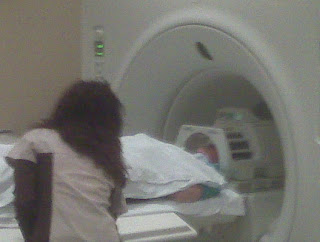Susan’s status is thankfully unchanged, if not slightly better as she’s doing well weaning off steroids. We’ll be back at UCLA next week for another MRI and clinic visit.
Given Susan’s brain cancer, a number of friends from church who died this year, and several more dear friends who are fighting for their lives against cancer and other disease, we approach Christmas with a deeper appreciation for what that manger held two thousand years ago.
But first, I’ll not call it a manger – that word brings to mind the safe image found in songs and sketches. It was a feed trough for livestock. Picture a crude wooden bin holding grain or hay, stained with the slobber of cows or donkeys or sheep. Maybe one of the animals had chewed away its edges. Maybe some hairs from a cow's neck were wedged in a splintered front board and drizzled with muddy spittle. You get the idea. As much as we love lighted nativity displays, the Creator of the universe slept in the type of feed trough found next to puddles of urine and piles of manure. In our day, “manger” sounds too clean.
The distance the Son of God traveled to become our Savior is important to grasp for people going through hard times. It shows that God enters impossibly into messy and hopeless places and will deliver us. Paul’s eloquence on the incarnation in Philippians 2:5-8 is astounding:
In your relationships with one another, have the same mindset as Christ Jesus: Who, being in very nature God, did not consider equality with God something to be used to his own advantage; rather, he made himself nothing by taking the very nature of a servant, being made in human likeness. And being found in appearance as a man, he humbled himself by becoming obedient to death — even death on a cross!
First Jesus made himself nothing. Then he humbled himself. He came down all the way then came down even more. Who is this God, anyway? How much must he love us that a member of the Trinity would leave the glory of heaven to enter our world? And what does it say about him that he avoided the splendor that should attend the arrival of the King of Kings, chose the most helpless form of human existence, and was placed a feed trough in an obscure Judean town?
That feed trough contained more than a baby – it contained love. Somehow, it contained the very source of love. The fact that God is all-powerful would be a terrible thing if he did not love us. We should fear his power and treasure his love. His power did for us what we could not do for ourselves in securing our salvation and eternal life, but his love made that power work on our behalf.
Love always has an object, a focus, what the lover can’t get out of his mind. For God, it’s us. Shall I summarize the Bible, the world’s best selling book of all time? The Bible is 1189 chapters contained in 66 books written by 40 men as they were inspired by God over a period of 1600 years. But we can pack over 773,000 words into just five: God is crazy about us. He’ll give us anything for our good because he loves us. His greatest gift to us was Jesus in that feed trough.
Love is costly. God’s love is unrestrained – he has paid dearly. Could we measure the cost of his creation, the cost of his disappointment at the fall of man, the cost of his incarnation, or the cost of his death and resurrection? It’s unimaginable. We can’t understand the extent of what God did for us, or why, but the heart of his plan was laid in that feed trough. Making himself nothing and then humbling himself means the One who spoke the world into existence would actually reduce his language for a time to coos and cries. The depth of God’s love for us means it’s okay with him if we don’t understand or appreciate its cost.
Love brings life. People who are loved become energized, brightened, and confident. Infants deprived of love become poorly developed. With love we live; without love, we die. Life came into the world and was placed in that feed trough, a new life born to Mary and Joseph, and eternal life for us through Jesus’ work on the cross. This life, this love, inspired the hymn writer to pen “Strength for today and bright hope for tomorrow, blessings all mine with ten thousand beside” (Great is Thy Faithfulness). This life and love are why we and others enduring hard times appreciate the meaning of Christmas.
It sounds weird to say, but these hardest days of our lives have also been our happiest. With Susan’s breast and brain cancers, we’ve experienced loss and turmoil – the stuff that comes with major crisis and upheaval. But we’re loved, and we’re learning good things about the God who loves us. Instead of despair, we’ve received joy, hope and peace. We have life with each other now and eternal life with God in heaven later. It’s such a gift. It’s all because of what was in that feed trough. Merry Christmas!







